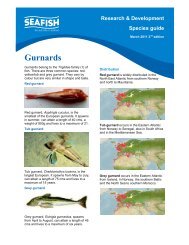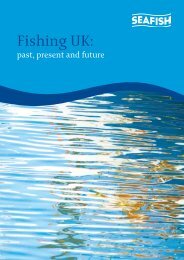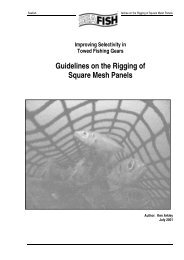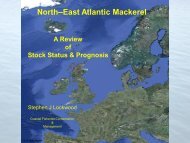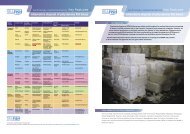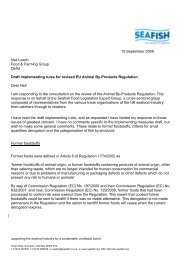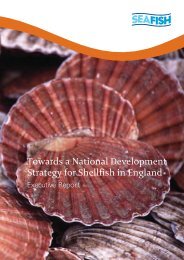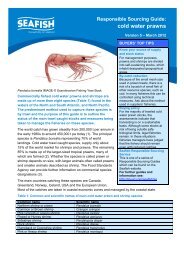University of Stirling - Tilapia and Europe - Seafish
University of Stirling - Tilapia and Europe - Seafish
University of Stirling - Tilapia and Europe - Seafish
You also want an ePaper? Increase the reach of your titles
YUMPU automatically turns print PDFs into web optimized ePapers that Google loves.
<strong>Tilapia</strong> <strong>and</strong> <strong>Europe</strong><br />
the unfulfilled potential <strong>of</strong> a farmed tropical<br />
whitefish in <strong>Europe</strong>an markets<br />
Dave Little <strong>and</strong> Francis Murray<br />
Sustainable Aquaculture Group, Institute <strong>of</strong> Aquaculture,<br />
<strong>University</strong> <strong>of</strong> <strong>Stirling</strong><br />
www.seatglobal.eu<br />
Interested to hear your views<br />
Text me now on 07746373382
Overview <strong>of</strong> talk<br />
• …tilapia ..just another generic<br />
whitefish?...the global alternative<br />
• <strong>Tilapia</strong> in the UK<br />
• Looking across the pond<br />
• Quality issues-<strong>of</strong>f flavour<br />
www.seatglobal.eu<br />
• Enhancing sustainability
Why tilapia..why now?<br />
Feeding low in the food chain<br />
Relatively high quality white fish<br />
Potential for contributing to <strong>Europe</strong>an fish security<br />
www.seatglobal.eu<br />
Scalable, geographically widespread <strong>and</strong> low water footprint
One fish—many systems<br />
• From extensive ponds to super-intensive RAS<br />
• Main systems for export intensively managed<br />
ponds <strong>and</strong> cages in reservoirs/lakes<br />
www.seatglobal.eu<br />
• Polycultures …increasingly with white<br />
shrimp- but carps <strong>and</strong> other finfish common
Diverse production systems<br />
…from systems dependent on<br />
feed out <strong>of</strong> a bag<br />
www.seatglobal.eu<br />
…to those entirely dependent on<br />
natural food within the system
www.seatglobal.eu<br />
Rise <strong>of</strong> cage culture?
Cages in tropical lakes<br />
www.seatglobal.eu<br />
http://www.lakeharvest<br />
.com/
Photo Israel Snir<br />
Intensive ponds
Balancing fertilizer <strong>and</strong> feeds in pond<br />
systems
Life cycle analysis to underst<strong>and</strong> global<br />
impacts<br />
www.seatglobal.eu<br />
• Low fillet yield (30-37%) lots <strong>of</strong> by-products<br />
• Higher proximate environmental impacts <strong>of</strong> cages-nutrient<br />
reuse, biodiversity, disease risks for cages compared to<br />
intensive ponds<br />
• Higher energy use in intensive ponds<br />
• Main impacts through feed<br />
• Increasing ‘functional carnivory’-even low amounts <strong>of</strong><br />
fishmeal <strong>and</strong> oil (3 <strong>and</strong> 1.5% respectively) have major impact<br />
• At these levels <strong>of</strong> use, net fishmeal producers<br />
• Overall favourable between broiler chicken <strong>and</strong> Atlantic<br />
salmon<br />
• Pelletier <strong>and</strong> Tyedmers 2010 Life Cycle Assessment <strong>of</strong> Frozen <strong>Tilapia</strong> Fillets From Indonesian Lake-Based<br />
<strong>and</strong> Pond-Based Intensive Aquaculture Systems J. Industrial Ecology
<strong>Tilapia</strong> in the UK<br />
• False dawns<br />
• Little real progress<br />
www.seatglobal.eu<br />
• Towards the local or embracing the<br />
global?
….history <strong>of</strong> local production<br />
• Poor design <strong>of</strong> facilities leading to production<br />
failures<br />
• Shared energy source failure<br />
• High costs<br />
• Poor returns in conventional markets<br />
www.seatglobal.eu<br />
• ‘This fish is a dud …it tastes <strong>of</strong> mud’<br />
• High Fernley Whittingstall… Telegraph journalist<br />
era..
<strong>Tilapia</strong> in barns…a radical form <strong>of</strong><br />
diversification….?<br />
• The concept - warmwater<br />
fish on conventional farms<br />
• Insulated farm buildings<br />
• Feed on bi<strong>of</strong>loc?<br />
• Locally produced feeds<br />
• Complexity <strong>and</strong> risk<br />
• Micro-production <strong>and</strong> local<br />
food chains
Simple conventional recirculating<br />
systems..not bi<strong>of</strong>loc
Local, high value markets<br />
• Product placement in a competitive context; Brixham<br />
<strong>and</strong> Dartmouth gastro pub, restaurant <strong>and</strong> wholesaler<br />
• Whole fish left with chefs to prepare, interviews with<br />
chefs, <strong>and</strong> customers<br />
• Celebrity chef refused to serve as no farmed fish sold<br />
in his establishment-<br />
• Competitive alternative to freshly caught seafish<br />
www.seatglobal.eu<br />
• Returns most sensitive to farm gate price <strong>and</strong> energy
Imports…<br />
www.seatglobal.eu<br />
• Very limited in <strong>Europe</strong> (2000MT), particularly<br />
in UK<br />
• Frozen Chinese whole fish (fresh markets)<br />
• Long-st<strong>and</strong>ing whole fish imports<br />
• Limited high end fillets-Waitrose; fresh now<br />
frozen<br />
• Competition with Pangasius<br />
• …<strong>and</strong> then the 2012 Olympics
…can we learn from across the pond?<br />
• “[UK] consumers are very habitual <strong>and</strong> not very experimental<br />
when it comes to fish – they like their cod <strong>and</strong> haddock, <strong>and</strong><br />
won’t easily adopt new species”<br />
“you’ve got to engage the households”, mainly through<br />
retailers, who themselves employ chefs <strong>and</strong> inspire menu ideas<br />
www.seatglobal.eu<br />
“It won’t be easy, it wasn’t easy in America, you’ve just got to<br />
grind it out.”<br />
Smith <strong>of</strong> Continental Food, in part inspired by exchanges he’d had with Mike Pichetti,<br />
the former Regal sales executive who was instrumental in opening up the US market to<br />
Regal’s tilapia.<br />
• Tallaksen 2013
Rapid progress in North America<br />
• Fresh, high quality product from Latin America <strong>and</strong><br />
frozen from Indonesia<br />
• Major growth <strong>of</strong> tilapia as pangasius trade was<br />
limited over the last decade<br />
• Now in the top 5 seafood products<br />
www.seatglobal.eu<br />
• Led the way for influx <strong>of</strong> a wide range <strong>of</strong> qualities,<br />
especially from China
The fresh tilapia industry started 35 years ag<strong>of</strong>romJamaica<br />
Mexico<br />
Jamaica<br />
Honduras<br />
www.seatglobal.eu<br />
Slide Israel Snir<br />
Costa Rica<br />
Colombia<br />
On <strong>Tilapia</strong> Sustainability <strong>and</strong> people - ISTA 9<br />
- CHINA 2011 - Israel <strong>and</strong> Yedod Snir<br />
Ecuador<br />
19
Market segmentation <strong>and</strong><br />
differentiation
..a wide <strong>and</strong> increasing range <strong>of</strong><br />
secondary processing in North<br />
America
A major challenge-consistent taste<br />
www.seatglobal.eu<br />
• Off flavours an increasingly common issue-to<br />
unpredictable changes in natural organisms in<br />
culture water<br />
• Can occur in any system<br />
– Salmon in RAS- its an issue<br />
– Shrimp –its an issue<br />
– Barramundi- a big issue<br />
• For tilapias –it has been a major factor in market<br />
development
Market impacts <strong>of</strong> <strong>of</strong>f-flavours<br />
For importers, a bad batch may be<br />
unsellable <strong>and</strong> hurt established<br />
business relationships.<br />
www.seatglobal.eu<br />
For retailers <strong>and</strong> food services, a<br />
single bad experience will drastically<br />
reduce repeat business<br />
Leading to negative perceptions <strong>of</strong><br />
the fish <strong>and</strong> can lead to reduced<br />
overall dem<strong>and</strong> <strong>and</strong> Lower Price.<br />
Fitzsimmons, 2011
China dominating production <strong>and</strong><br />
export<br />
Brazil, 3.80%<br />
Thail<strong>and</strong>, 7.59%<br />
Philippines,<br />
9.63%<br />
else, 6.65%<br />
Colombia, 1.12%<br />
Honduras, 1.13%<br />
Malaysia, 1.29%<br />
Taiwan Province<br />
<strong>of</strong> China, 3.04%<br />
China<br />
2007<br />
Egypt<br />
Indonesia<br />
Philippines<br />
Thail<strong>and</strong><br />
Brazil<br />
Taiwan Province <strong>of</strong> China<br />
Malaysia<br />
Honduras<br />
Colombia<br />
else<br />
China, 45.25%<br />
Indonesia,<br />
9.91% Egypt, 10.61%<br />
www.seatglobal.eu<br />
More than 75% <strong>of</strong> tilapia globally<br />
traded from China
www.seatglobal.eu<br />
Where is tilapia produced in China?
www.seatglobal.eu<br />
Rapid, but recent growth
www.seatglobal.eu<br />
…export growth even more recent
www.seatglobal.eu<br />
…will the export rise continue?
www.seatglobal.eu<br />
Value-adding?
www.seatglobal.eu<br />
Export nodes
www.seatglobal.eu<br />
Where in Guangdong?
www.seatglobal.eu<br />
The Maoming triangle
www.seatglobal.eu<br />
Mainly ponds, cages constrained by<br />
water constraints
www.seatglobal.eu<br />
Intensified pond management
www.seatglobal.eu<br />
Engaging with Chinese stakeholders
www.seatglobal.eu<br />
M<strong>and</strong>ating taste testing across the<br />
sector
New entrants in Asia<br />
www.seatglobal.eu<br />
• Thail<strong>and</strong> has a large<br />
domestic market for<br />
tilapia that has grown<br />
<strong>and</strong> diversified into<br />
multiple segments<br />
• Growth has slowed but<br />
export markets need to<br />
methods that can<br />
produce competitively<br />
<strong>and</strong> without <strong>of</strong>f flavour
Action research on <strong>of</strong>f-flavour tilapia<br />
• Off-flavour is limiting exports<br />
<strong>and</strong> value<br />
• Quality control is good<br />
• Supply <strong>of</strong> on-flavour fish limited<br />
Observe<br />
Reflect<br />
Outsider Expertise<br />
Stakeholder<br />
Experience<br />
www.seatglobal.eu<br />
Act<br />
• Workshops with farmers<br />
• Discussions with processors<br />
• Pond trials at demonstration<br />
farms<br />
Plan<br />
• Explore awareness along supply chain<br />
• Trial pond system for reducing <strong>of</strong>f-flavours
St<strong>and</strong>ards <strong>and</strong> certification<br />
www.seatglobal.eu<br />
• Are they providing the right levers towards<br />
greater sustainability?<br />
• Full-cycle feedlot in cages in pristine tropical<br />
lakes compared to pond-based production?<br />
• Towards st<strong>and</strong>ards that are green-water based<br />
(learning lessons from shrimp)<br />
• May need marketing <strong>of</strong> ‘cream is good’
Research<br />
LU WFC UCPH WU<br />
DIIS<br />
KU CTU SFU BAU<br />
UOS<br />
<strong>Europe</strong> Stakeholders Asia<br />
Coordination<br />
Action<br />
www.seatglobal.eu<br />
UB<br />
CEFAS<br />
FAO
Underst<strong>and</strong>ing <strong>and</strong> improving sustainability<br />
Scoping <strong>and</strong> boundary setting<br />
Current<br />
Ethical issues<br />
Social <strong>and</strong><br />
economic<br />
impacts<br />
Public<br />
health<br />
Lo<br />
impacts<br />
Contaminant<br />
modelling<br />
Life cycle analysis<br />
Local<br />
environment<br />
modelling<br />
www.seatglobal.eu<br />
Improved<br />
Policy<br />
implications<br />
Action research along the value chain<br />
Ethical Aquatic Food Index
EAFI<br />
www.seatglobal.eu<br />
• Certification systems- to support further<br />
development<br />
• Whole value chain approach-LCA ++<br />
• Holistic approach –weighting <strong>of</strong> values<br />
• Not another st<strong>and</strong>ard but an interactive tool<br />
to support st<strong>and</strong>ards development <strong>and</strong><br />
sustainable seafood sourcing
www.seatglobal.eu<br />
Could you use the EAFI?<br />
• Contribute to the EAFI development contact<br />
Jason Weeks (jason.weeks@cefas.co.uk)<br />
• Check out progress at www.seatglobal.eu<br />
• Text (on 07746373382) or email us<br />
dcl1@stir.ac.uk; fjm3@stir.ac.uk




